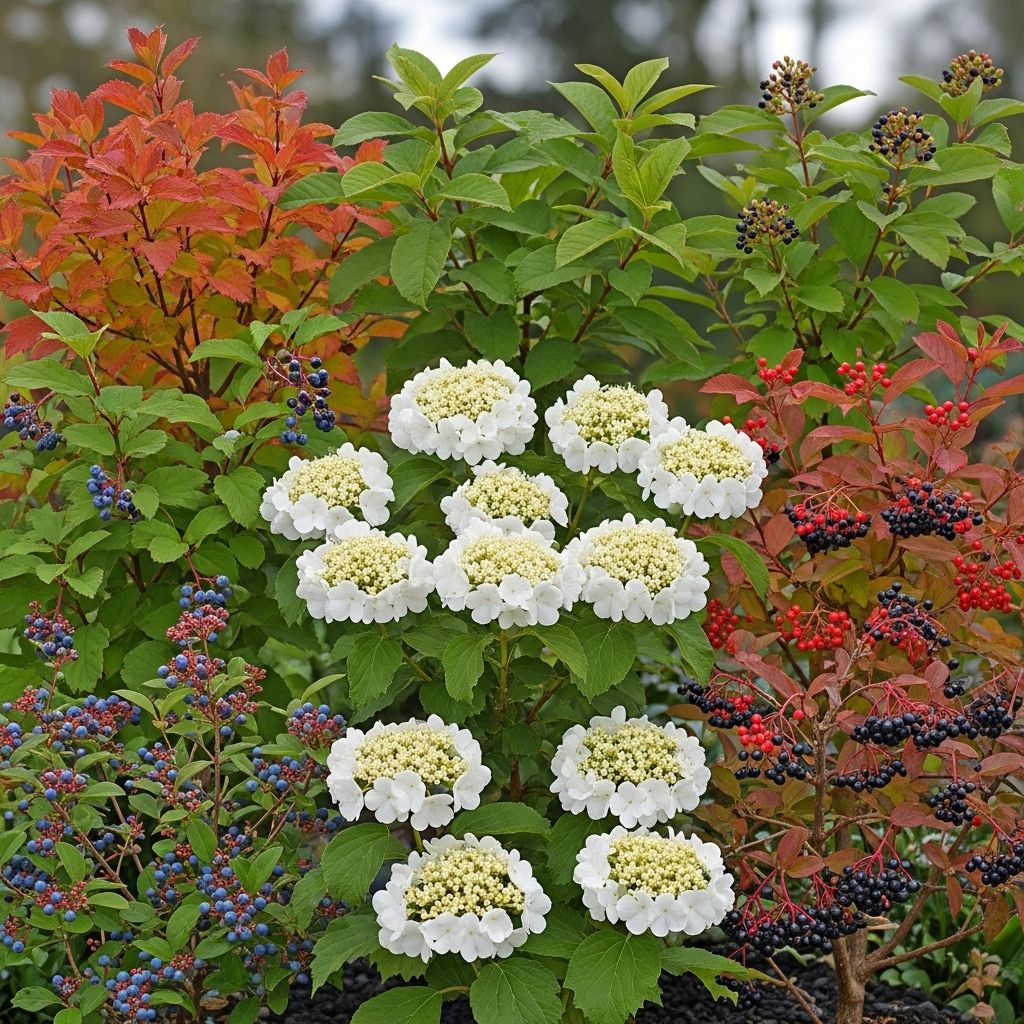Top 10 Favorite Viburnums for Multi-Season Beauty
Shrubs that bloom in winter, scent the spring garden, and offer berries for birds.

Image: HearthJunction Design Team
10 Favorite Viburnums for Every Garden
Viburnums are the ultimate multitaskers of garden shrubs, offering year-round interest with their stunning blooms, lush foliage, vibrantly colored berries, and autumn displays. This guide outlines ten exceptional viburnums—each chosen for standout beauty, fragrance, or wildlife appeal—to help you grow a more charismatic and biodiverse garden.
Why Choose Viburnums?
- Extended seasonal interest: Flowers in spring, berries in summer and autumn, striking fall color.
- Wildlife value: Fruits attract birds, pollinators visit blooms.
- Versatility: Grow in sun or shade; suit formal, informal, and wildlife-friendly gardens.
- Low maintenance: Adaptable to many soils and resistant to common pests and diseases.
1. Viburnum × bodnantense ‘Dawn’
Bodnant viburnum stands out for its sweetly perfumed pink flowers that bloom from late winter into early spring. The upright, arching habit makes it a striking specimen, especially when planted where its scent can be enjoyed on chilly days.
- Height & Spread: 8–10 feet tall and wide
- Zone: 5–8
- Best Features: Fragrant flowers on bare branches in winter and early spring
2. Korean Spice Viburnum (Viburnum carlesii)
If you crave fragrance in the garden, Korean spice viburnum is a must. In mid-spring, deep pink buds open into clusters of pale pink to white flowers. Their intoxicating, spicy-sweet scent is among the best in the plant world. This slow-growing shrub also offers attractive autumn color.
- Height & Spread: 4–6 feet tall and wide
- Zone: 4–8
- Best Features: Exceptional fragrance; showy spherical blossoms; colorful fall foliage
- Garden Uses: Hedges, specimen plant, borders; flowers can be used for infusing syrups or honey
3. Chinese Snowball Viburnum (Viburnum macrocephalum)
This snowball viburnum dazzles with dramatic, pompom-like white flower heads up to 8 inches across in late spring. The flowers start lime-green and mature to white, creating architectural interest. Largely sterile, so produces few berries.
- Height & Spread: 12–20 feet tall and wide
- Zone: 6–9
- Best Features: Giant globe-shaped flower clusters
- Garden Uses: Large borders, lawn specimen, cut flowers
4. Doublefile Viburnum (Viburnum plicatum tomentosum ‘Mariesii’)
Noted for its layered, elegant horizontality, doublefile viburnum produces tiers of white flowers in mid- to late spring, followed by ornamental red-to-black berries. Its deeply veined foliage adds texture, and the rich fall color is an additional treat.
- Height & Spread: 6–10 feet tall; up to 12 feet wide
- Zone: 5–8
- Best Features: Layered branch structure; masses of white lacecap flowers
- Garden Uses: Hedges, screens, large borders
5. Judd Viburnum (Viburnum × juddii)
This hybrid viburnum is renown for strong spicy-sweet fragrance and rounded clusters of white flowers in mid-spring. Judd viburnum is also prized for its disease resistance and manageable size.
- Height & Spread: 6–8 feet tall and wide
- Zone: 4–8
- Best Features: Fragrant blooms; good fall leaf color
6. Leatherleaf Viburnum (Viburnum rhytidophyllum)
This bold evergreen to semi-evergreen species boasts large, rugged, leathery leaves and domed clusters of creamy white flowers. Leatherleaf viburnum thrives in difficult spots, including shade, and produces blue-black fruit clusters that persist into winter.
- Height & Spread: 8–12 feet tall and wide
- Zone: 5–8
- Best Features: Year-round presence; distinctive foliage; tolerant of tough conditions
7. David Viburnum (Viburnum davidii)
Compact and largely evergreen, David viburnum is a favorite for foundation plantings. Its small size, lustrous dark green leaves, and metallic blue berries (with both male and female plants) make it an appealing, tidy choice for modern gardens.
- Height & Spread: 3–4 feet tall and wide
- Zone: 7–9
- Best Features: Evergreen leaves; striking blue berries; compact habit
8. Arrowwood Viburnum (Viburnum dentatum)
Vital for wildlife gardens, arrowwood viburnum features white flower clusters in late spring and appealing blue berries that ripen in early fall—highly attractive to birds. This hardy, native shrub tolerates a range of soils and is excellent for naturalistic borders or hedges.
- Height & Spread: 6–10 feet tall and wide
- Zone: 3–8
- Best Features: Bee- and bird-friendly; tough and adaptable
9. Blackhaw Viburnum (Viburnum prunifolium)
This North American native is beloved for sprays of creamy white flowers, pink-tinged berries that turn blue-black, and burgundy fall leaves. The berries are edible and have a sweet, raisin-like flavor, making blackhaw viburnum as useful as it is ornamental.
- Height & Spread: 12–15 feet tall; 6–12 feet wide
- Zone: 3–9
- Best Features: Wildlife food plant; four-season interest; edible fruit
10. American Cranberrybush (Viburnum opulus var. americanum)
This cranberrybush viburnum offers showy, lacecap flowers in late spring, brilliant red berries, and fiery red fall foliage. The tart, edible berries can be used in jams and jellies and are loved by birds. It prefers moist soils and provides exceptional wildlife habitat.
- Height & Spread: 8–12 feet tall and wide
- Zone: 2–7
- Best Features: Showy flowers; edible fruit; fall foliage
Caring for Viburnums: Tips for a Thriving Shrub
- Light: Most viburnums grow best in full sun to partial shade. Some, like leatherleaf, tolerate deep shade.
- Soil: Viburnums are tolerant of a range of soil types but thrive in well-drained, moderately fertile soils.
- Water: Although many are drought-tolerant once established, new plants need consistent moisture.
- Pruning: Prune immediately after flowering for shape and to prevent loss of next year’s blooms (most bloom on old wood).
- Feeding: Feed in early spring with a balanced fertilizer if growth is slow or foliage is pale.
Table: Viburnum Selection at a Glance
| Viburnum Species | Main Asset | Mature Size (H x W, ft) | Zone |
|---|---|---|---|
| V. × bodnantense ‘Dawn’ | Winter fragrance | 8–10 x 8–10 | 5–8 |
| Korean spice (V. carlesii) | Fragrant blooms | 4–6 x 4–6 | 4–8 |
| Chinese snowball (V. macrocephalum) | Giant flower spheres | 12–20 x 12–20 | 6–9 |
| Doublefile (V. plicatum tomentosum ‘Mariesii’) | Layered blooms | 6–10 x 12 | 5–8 |
| Judd (V. × juddii) | Fragrance, color | 6–8 x 6–8 | 4–8 |
| Leatherleaf (V. rhytidophyllum) | Evergreen presence | 8–12 x 8–12 | 5–8 |
| David (V. davidii) | Compact, blue berries | 3–4 x 3–4 | 7–9 |
| Arrowwood (V. dentatum) | Wildlife habitat | 6–10 x 6–10 | 3–8 |
| Blackhaw (V. prunifolium) | Native, edible | 12–15 x 6–12 | 3–9 |
| American cranberrybush (V. opulus var. americanum) | Edible berries, autumn color | 8–12 x 8–12 | 2–7 |
Growing Native Viburnums: Ecological and Practical Perks
Native viburnums not only adapt easily to local conditions but also support pollinators and wildlife. Their attractive fruits are a critical food source for birds and other animals, while the overall resilience of these species results in low-maintenance, naturally beautiful gardens. In most regions, local species will thrive with minimal use of water or fertilizer and provide substantial ecological benefits.
Design Ideas: Where to Plant Viburnums
- Hedging and privacy screens: Many viburnums, such as arrowwood or doublefile, make excellent living boundaries.
- Specimen planting: Showy types—like Chinese snowball—act as eye-catching focal points in lawns or mixed borders.
- Shade gardens: Try leatherleaf or David viburnum for year-round foliage in dappled or high shade settings.
- Wildlife gardens: Arrowwood, blackhaw, and cranberrybush are essential for bird- and pollinator-friendly landscapes.
Frequently Asked Questions (FAQs)
Q: Can I grow viburnums in partial shade?
A: Yes. While most viburnums prefer full sun for the best blooms and berry color, several types—including leatherleaf and David viburnum—thrive in partial shade. In deep shade, flowering and fruiting may be reduced.
Q: Are viburnums deer-resistant?
A: Some species, especially those with leathery or aromatic foliage (like leatherleaf viburnum), tend to be less appealing to deer. However, deer may browse young shoots of less resistant types.
Q: Which viburnums have the best fragrance?
A: Korean spice viburnum, Judd viburnum, and bodnant viburnum ‘Dawn’ are especially noted for their powerful, spicy-sweet scents—often compared to daphne or lilac.
Q: What pests and diseases affect viburnums?
A: Viburnums are generally resilient, but some may suffer from aphids or powdery mildew, especially if grown in poor air circulation. Choose resistant species and plant in suitable conditions to reduce problems.
Q: Do all viburnums have colorful berries?
A: Most do, but some, like certain snowball types, are sterile and produce few or no berries. If berries are a design priority, select types noted for their fruit display such as blackhaw, arrowwood, or David viburnum (with both male and female plants nearby).
Final Thoughts
With a range of forms, flower styles, fragrances, and seasonal displays, viburnums are among the most rewarding and reliable shrubs for any landscape. Whether you want fragrance, wildlife value, fall color, or low maintenance structure, there is a viburnum to fit every need and taste.
References
- https://www.finegardening.com/article/viburnums-are-versatile-shrubs
- https://www.gardenia.net/guide/us-native-viburnums-ideal-shrub-for-your-garden
- https://www.gardenista.com/posts/favorite-shrubs-with-white-flowers/
- https://www.gardenista.com/posts/favorite-viburnums/
- https://www.gardenista.com/tag/viburnums/
Read full bio of Shinta












